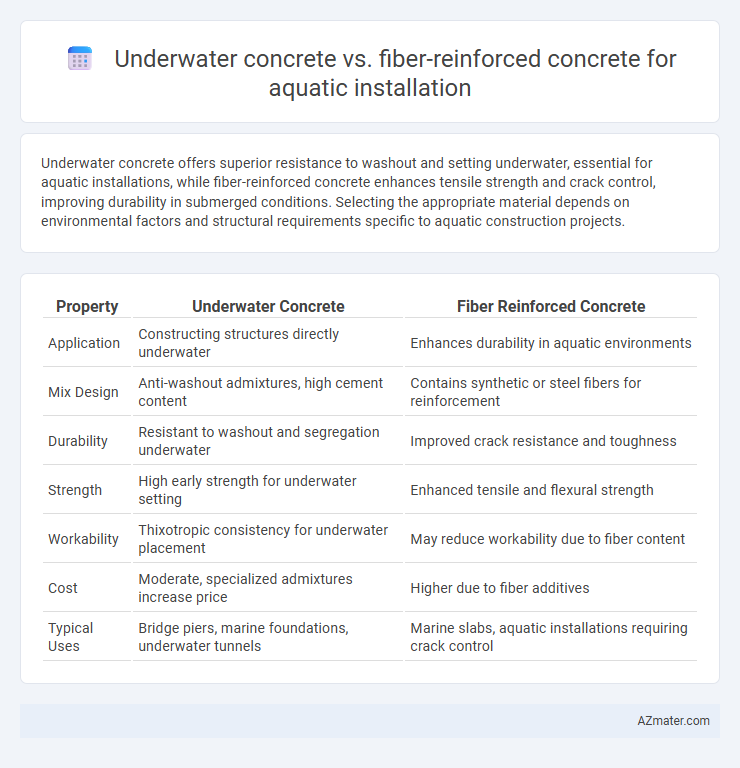Underwater concrete offers superior resistance to washout and setting underwater, essential for aquatic installations, while fiber-reinforced concrete enhances tensile strength and crack control, improving durability in submerged conditions. Selecting the appropriate material depends on environmental factors and structural requirements specific to aquatic construction projects.
Table of Comparison
| Property | Underwater Concrete | Fiber Reinforced Concrete |
|---|---|---|
| Application | Constructing structures directly underwater | Enhances durability in aquatic environments |
| Mix Design | Anti-washout admixtures, high cement content | Contains synthetic or steel fibers for reinforcement |
| Durability | Resistant to washout and segregation underwater | Improved crack resistance and toughness |
| Strength | High early strength for underwater setting | Enhanced tensile and flexural strength |
| Workability | Thixotropic consistency for underwater placement | May reduce workability due to fiber content |
| Cost | Moderate, specialized admixtures increase price | Higher due to fiber additives |
| Typical Uses | Bridge piers, marine foundations, underwater tunnels | Marine slabs, aquatic installations requiring crack control |
Introduction to Aquatic Concrete Installations
Aquatic concrete installations require materials that withstand constant water exposure, high pressure, and chemical corrosion. Underwater concrete, formulated for direct placement in water, offers rapid setting and strong bonding without requiring dewatering, making it ideal for underwater foundations and repairs. Fiber reinforced concrete enhances tensile strength and crack resistance, proving valuable for aquatic structures needing durability and flexibility under dynamic water conditions.
Overview of Underwater Concrete
Underwater concrete is specifically designed to maintain stability and strength when placed underwater, utilizing anti-washout admixtures and controlled rheology to prevent segregation and loss of cementitious materials. This specialized concrete ensures durability and impermeability in aquatic installations such as bridge piers, tunnels, and offshore structures by resisting hydrostatic pressure and preventing water ingress. Fiber reinforced concrete, while enhancing tensile strength and crack resistance, often serves as a complementary material rather than a replacement in underwater conditions due to its potential for reduced workability underwater.
Understanding Fiber Reinforced Concrete
Fiber reinforced concrete (FRC) enhances durability and crack resistance in aquatic installations by integrating synthetic or steel fibers into the mix, which improves tensile strength and impact resistance. Unlike conventional underwater concrete that relies on anti-washout admixtures to maintain cohesion during placement, FRC provides intrinsic reinforcement, reducing the need for extensive formwork and preventing premature structural failure. This makes fiber reinforced concrete particularly suitable for submerged structures exposed to dynamic water forces and harsh environmental conditions.
Material Composition and Properties
Underwater concrete is specifically formulated with anti-washout admixtures and high cement content to maintain cohesion and strength during underwater placement, ensuring durability in aquatic environments. Fiber reinforced concrete incorporates synthetic or steel fibers that enhance tensile strength, crack resistance, and structural integrity, making it ideal for withstanding dynamic water pressures and impacts. The material composition of underwater concrete emphasizes workability and washout resistance, whereas fiber reinforced concrete prioritizes mechanical reinforcement and durability under aquatic loading conditions.
Installation Methods in Aquatic Environments
Underwater concrete relies on tremie or pumped placement methods to prevent segregation and washout during aquatic installation, ensuring cohesive material integrity. Fiber reinforced concrete (FRC) enhances structural durability by integrating synthetic or steel fibers that improve crack resistance, allowing for more flexible application methods such as sprayed or cast-in-place underwater techniques. Both materials require specialized equipment and careful handling to maintain performance, but FRC provides added toughness that benefits long-term aquatic structures.
Durability and Longevity Under Water
Underwater concrete demonstrates superior durability due to its specialized mix design that minimizes washout and enhances cohesion during underwater placement, ensuring long-term structural integrity in aquatic environments. Fiber reinforced concrete, while improving crack resistance and tensile strength through polymer or steel fibers, may experience reduced durability underwater if not properly formulated to resist marine chemical attacks and abrasion. Selecting underwater concrete optimized for reduced permeability and high sulfate resistance typically results in greater longevity and performance for submerged infrastructure compared to standard fiber reinforced counterparts.
Resistance to Corrosion and Chemical Attack
Underwater concrete exhibits superior resistance to corrosion and chemical attack due to its dense matrix and specialized admixtures that reduce permeability, making it ideal for aquatic installations exposed to aggressive marine environments. Fiber reinforced concrete enhances durability by improving crack resistance and toughness, yet its corrosion resistance depends on the type of fiber used, with synthetic fibers outperforming steel fibers in chemical stability. Selecting underwater concrete ensures optimal long-term protection against chloride-induced corrosion and sulfate attack, critical for submerged structures in aquatic settings.
Structural Performance and Load Capacity
Underwater concrete exhibits excellent compressive strength and durability in submerged conditions, making it highly resistant to washout and chemical attacks, essential for aquatic installations. Fiber reinforced concrete enhances structural performance by improving tensile strength, crack control, and impact resistance, thereby increasing the load capacity and durability of aquatic structures under dynamic water pressures. Combining fibers with underwater concrete formulations optimizes both load-bearing capacity and long-term structural integrity in harsh aquatic environments.
Cost Analysis and Economic Considerations
Underwater concrete typically incurs higher costs due to specialized admixtures, placement techniques, and extended curing times required to ensure durability and strength in submerged environments. Fiber reinforced concrete, while potentially reducing labor and maintenance expenses through enhanced crack resistance and durability, may involve higher initial material costs depending on fiber type and dosage. Economic considerations must weigh the long-term lifecycle savings of fiber reinforcement against the immediate increased expenditure associated with underwater concrete's complexity and specialized equipment.
Best Applications: Choosing the Right Concrete Type for Aquatic Projects
Underwater concrete is ideal for applications requiring rapid setting and high resistance to washout in submerged conditions, making it suitable for pier foundations, underwater tunnels, and marine structures. Fiber reinforced concrete enhances tensile strength and crack resistance, benefiting aquatic installations exposed to dynamic loads or vibrations, such as docks, seawalls, and splash zones. Selecting the right concrete depends on project-specific demands like exposure to water pressure, structural load, and durability requirements in aquatic environments.

Infographic: Underwater concrete vs Fiber reinforced concrete for Aquatic installation
 azmater.com
azmater.com